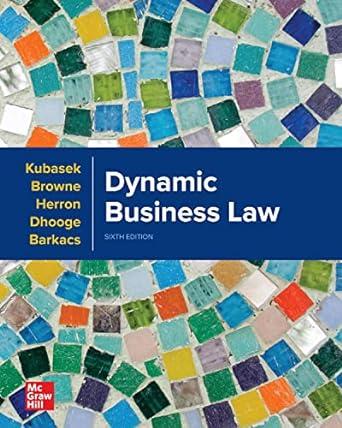Petra Beierling had formed a concept for an educational software business marketing online learning games to teachers.
Question:
Petra Beierling had formed a concept for an educational software business marketing online learning games to teachers. She pitched the idea to two friends, Katie Urbain and Maureen Clinesmith. The three formed a partnership which lasted from November 2009 to February 2010. Clinesmith loaned the partnership money instead of investing \($10,000\) as she had initially agreed. Urbain, Clinesmith, and Bierling subsequently agreed to be equal partners and split the profits evenly after Clinesmith’s loan was repaid.
The partnership did not have a written agreement.
The partners intended to launch the website in early February 2010. However, the website launch was delayed due to several issues, including a clash of personalities between Beierling and Urbain. The personality clash resulted in Beierling informing Urbain that Urbain was no longer part of the partnership.
Beierling and Clinesmith eventually dissolved the partnership and created a new partnership with only themselves as partners. Despite the new partnership’s efforts, the new partnership sold only one unit for \($69.99.\) Urbain filed an instant action against Beierling and Clinesmith, requesting an accounting and alleging breach of partnership agreement, breach of fiduciary duty, breach of duty to render information, improper dissolution of the partnership, civil conspiracy, and concert of action.
The trial court granted the defendant’s motion for summary disposition on all claims and Urbain appealed.
OPINION PER CURIAM Plaintiff next asserts that she had a right to account for her interests in the partnership on the date of its dissolution.
MCL 449.40 sets forth rules for distributing partnership property upon dissolution of a partnership.
In general, MCL 449.40
(b) provides that creditors should be paid first, then monies owed to partners for liabilities other than for capital and profits, followed by distribution of capital and, finally, profits to partners. Valuation should be made at the time of dissolution, and the winding-up of partnership affairs entails gathering the assets, paying and settling debts, and distributing any net surplus to parties entitled to it. Under MCL 449.37, “partners who have not wrongfully dissolved the partnership… [have] the right to wind up the partnership affairs[.]” Thus, defendants should have afforded plaintiff an opportunity to be involved in the winding-up of partnership affairs.
The record reveals that plaintiff had no input whatsoever in the windup process because Beierling and Clinesmith took sole control of all partnership affairs, including the launch of the website and partnership finances. Clinesmith, the partner responsible for accounting duties, testified with regard to winding-up partnership affairs that she “personally look[ed] at the financials and recognized that there [were] only expenses. There were no profits.” She testified:
At that time there had not even been a sale. I looked at the fact that we had a website, that we had domain names, we had some games that were created, and in my estimation the value was less than the \($10,000\) that I had spent so far on the company, so I assumed the assets.
It appears from Clinesmith’s testimony that she attempted to marshal partnership assets, value the assets at the time of dissolution, and distribute those assets.
Unfortunately, there was no surplus of assets over and above the \($10,000\) loan from Clinesmith. Undoubtedly, defendants did not allow plaintiff to engage in any of the activities necessary to properly wind up the partnership. However, plaintiff has again failed to show that she was damaged.
Plaintiff testified that she was aware of the \($10,000\) capital loan that Clinesmith had made to the partnership and that the loan was to be repaid before any partnership assets or profits would be distributed to the partners. This approach was consistent with MCL 449.40(b).
While it would have been prudent to have a valuation of the partnership’s website and other intangibles calculated at the time of partnership’s dissolution, doing so would have been a formidable task considering that the website had not yet launched. In any event, it appears that the market set the value of the business after the website’s launch when only one sale was generated despite extensive targeted marketing to industry professionals. While plaintiff claims that she was a “co-owner” of partnership property, the record reveals that there were no assets or profits to distribute to her. Accordingly, the trial court properly granted summary disposition for defendants on plaintiff’s dissolution-of-partnership claim.
CRITICAL THINKING:
How do you react to the evidence in this case? Does it strike you as incomplete? What additional information would you like to have if you were deciding the case?
ETHICAL DECISION MAKING:
What primary values did the court uphold in its decision? If you were the judge reviewing the case, which values would motivate your decision?
Step by Step Answer:

Dynamic Business Law
ISBN: 9781260733976
6th Edition
Authors: Nancy Kubasek, M. Neil Browne, Daniel Herron, Lucien Dhooge, Linda Barkacs





